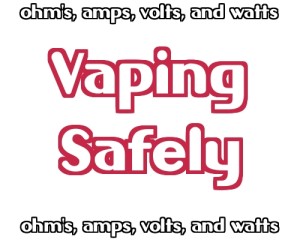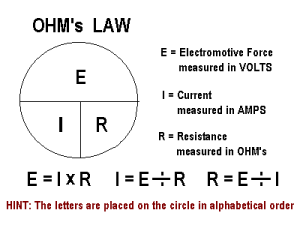 E-Cigarette Mechanics
E-Cigarette Mechanics
Every e-cigarette/atomizer combination provides power through a function of amps, ohms, volts and watts.
Although these terms can be confusing, to vape safely you need to have a basic understanding of how each function works. That way you can replace each part of your set up and safely enjoy a vape. In this article we’ll discuss how different ohm loads, paired with different amounts of volts or watts effect the amperage.
We’ll also discuss the difference between voltage and wattage as a power gauge.
Here are the mechanics of what is happening in a common e-cigarette set-up:
- They fire at a regulated 3.7 volts.
- Generally their atomizer is a preinstalled coil of around 1.5 ohms.
- This creates about 2.4 amps
- Once we know the amperage we can determine that the wattage will be around 9 watts
So what the hell does that mean?
To put it simply electrical currents are a lot like water currents and rivers.
3.7 volts is the amount of power coming from the battery. This is the volume of electricity. Compared to most power sources, 3.7 volts is like a puddle
- -In mechanical mods (without a kick device) the firing voltage will depend on the overall charge left in the battery. (4.2 volts at full charge and decreases to 3.4 volts when the battery is out of charge)
- -In a regulated device (variable voltage) you can decide what voltage you’d like to fire at. This also reduces the amount of time your battery will last.
1.5 ohms is the resistance to the current, or flow of power. Resistance is like large rocks creating drag on the flow of the river, slowing it down. Higher ohms is more resistance, and lower ohms is less.
- Replaceable coils/cartomizers/atomizers are labeled and sold at a specific ohm load.
- Rebuildable coils must always be checked with an ohm reader, or a device with an ohm read feature (such as the MVPv2, Vamo, VTR etc.)
2.4 amps is the draw of power from the battery. This is the overall speed of the current. Batteries are rated on the amount of amperage they can produce.
- Regulated devices have their own amperage limit, so putting a 30 amp battery in a 5 amp Vamo won’t increase the amperage limit.
9 watts is the total amount of power. It takes into consideration the amperage and the voltage.
To reiterate,
Low Ohms -> 3.7 volts -> High watts -> High amps
 Ohms law states that:
Ohms law states that:
I(amps)=V(volts)/R(Ohms resistance)
or
1.5 ohms/3.7 volts = 2.4 amps
To find out the wattage of the set up:
W(Wattage)=V * A
or
3.7 volts * 2.4 amps = 9 watts
Hooray! Middle school math!
Increase the ohms, without increasing the voltage and the watts and amps will go down.
A regulated device generally has its own amperage limit, so if you try to fire a coil with too low of an ohm load at too high of a voltage your device won’t fire. However, mechanical mods do not have this safety feature. So, you should use a vaping calculator make sure your battery is able to handle the amperage. Check out our vape battery safety guide for even more information.
Examples of batteries
- An Itaste MVP v2 has a 4 amp limit, so I can take it to it’s highest voltage (5 volts) and have no problems with a coil above 1.2 ohms.
- The Sony VTC4 18650 battery has a 30 amp limit, so I can vape it at its full charge (4.2 volts) and have no worries with a coil above 0.14 ohms
We also have some really cool Vaping Power chart Cheat Sheets you can print out. They show you the power output when you know the battery voltage and atomizer resistance (Ohm).
Related Safety Guides
You might also be interested in our other Vaping Safety guides:

Thanks for this basic info, Stephen. I enjoyed it.
I’m still trying to wrap my head around the math, and so will refer back to this post when needed.
By all means, keep writing more about the basics of vaping with mods.
I loved the article, but didn’t you make a mistake in writing one of your equations? You have the sample I = V/R, but when you take it down to insert the current information into the equation, you write R/V = I. I don’t know about you, but when I went to school, no matter which direction you wrote the equation, the integers were still added the same way. So which is the correct formula
I = V/R or R/V = I? They both aren’t going to give you anywhere close to the same amperage.
I feel pretty stupid after reading that, but appreciate the value of that kind of info. Mods are way beyond my experience level for now, but I do have a more basic question. Replacement coils for many tanks ask for choice of ohms (1.5, 1.8, 2.2, 2.5). I don’t know why one would be preferred over another or, even worse, if one might cause problems. As a new vaper, I love to read this material but really appreciate the occasional nod to people like me who are starting from scratch, but willing to learn.
Usually the lower resistance (ohm) a coil is the more power they use creating more vapor. If you have a variable voltage/wattage device you can always adjust the power output so the ohm of the coil matters less. Usually more advanced vapors like lower ohm coils. The benefits of higher ohm coils is that they use less power so you battery lasts longer and the coil itself may even last longer. It can also change the flavor of the vape.
Thank you for explaining that. Hopefully, the anti e cig zealots won’t ruin this hobby for those of us who just want to find a few flavors we enjoy and a few devices that are fun to fool sound with. As a former cigarette smoker who quit 30 years ago, I’m enjoying the hell of this so far!!
I’m in love with vaping!! I’m going by handle poor-vapor as of now.. Lol only due to not able to buy all toys. But I do love to window shop and finding more out every day.. Keep at it guys , loving what ya doing!!